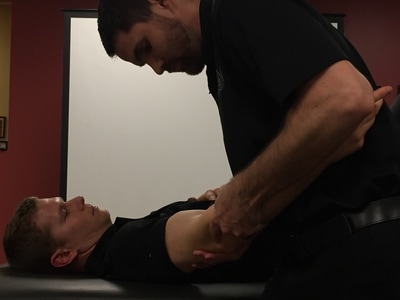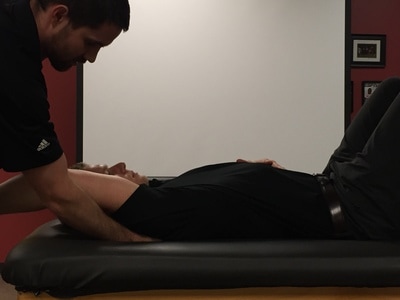- Home
- About Us
- TSPT Academy
- Online Courses
-
Resources
- Newsletter
- Business Minded Sports Physio Podcast
- Day in the Life of a Sports PT
- Residency Corner
-
Special Tests
>
-
Cervical Spine
>
- Alar Ligament Test
- Bakody's Sign
- Cervical Distraction Test
- Cervical Rotation Lateral Flexion Test
- Craniocervical Flexion Test (CCFT)
- Deep Neck Flexor Endurance Test
- Posterior-Anterior Segmental Mobility
- Segmental Mobility
- Sharp-Purser Test
- Spurling's Maneuver
- Transverse Ligament Test
- ULNT - Median
- ULNT - Radial
- ULNT - Ulnar
- Vertebral Artery Test
- Thoracic Spine >
-
Lumbar Spine/Sacroiliac Joint
>
- Active Sit-Up Test
- Alternate Gillet Test
- Crossed Straight Leg Raise Test
- Extensor Endurance Test
- FABER Test
- Fortin's Sign
- Gaenslen Test
- Gillet Test
- Gower's Sign
- Lumbar Quadrant Test
- POSH Test
- Posteroanterior Mobility
- Prone Knee Bend Test
- Prone Instability Test
- Resisted Abduction Test
- Sacral Clearing Test
- Seated Forward Flexion Test
- SIJ Compression/Distraction Test
- Slump Test
- Sphinx Test
- Spine Rotators & Multifidus Test
- Squish Test
- Standing Forward Flexion Test
- Straight Leg Raise Test
- Supine to Long Sit Test
-
Shoulder
>
- Active Compression Test
- Anterior Apprehension
- Biceps Load Test II
- Drop Arm Sign
- External Rotation Lag Sign
- Hawkins-Kennedy Impingement Sign
- Horizontal Adduction Test
- Internal Rotation Lag Sign
- Jobe Test
- Ludington's Test
- Neer Test
- Painful Arc Sign
- Pronated Load Test
- Resisted Supination External Rotation Test
- Speed's Test
- Posterior Apprehension
- Sulcus Sign
- Thoracic Outlet Tests >
- Yergason's Test
- Elbow >
- Wrist/Hand >
- Hip >
- Knee >
- Foot/Ankle >
-
Cervical Spine
>
- I want Financial Freedom
- I want Professional Growth
- I want Clinical Mastery
Chair Sign
Purpose: To assess for radial collateral ligament insufficiency of the elbow.
Test Position: Sitting.
Performing the Test: The patient is instructed to sit with forearms supinated and arms abducted greater than shoulder width. Next have the patient fully extend their elbows. A positive test is if apprehension occurs with terminal extension of the involved elbow or reluctance to push through arms.
Diagnostic Accuracy: Unknown.
Importance of Test: According to Neumann, the lateral collateral ligament complex of the elbow involves the radial collateral ligament and the lateral (ulnar) collateral ligament. Both parts have a common attachment to the lateral epicondyle. The RCL blends with the annular ligament, while the lateral (ulnar) collateral ligament attaches to the supinator crest of the ulna. They help resist varus forces and also provide posterolateral stability. With posterolateral instability, apprehension is felt with external rotation of the forearm due to increased risk of subluxation of the humeroulnar and humeroradial joints.
Note: these tests should only be used by properly trained health care practitioners
Test Position: Sitting.
Performing the Test: The patient is instructed to sit with forearms supinated and arms abducted greater than shoulder width. Next have the patient fully extend their elbows. A positive test is if apprehension occurs with terminal extension of the involved elbow or reluctance to push through arms.
Diagnostic Accuracy: Unknown.
Importance of Test: According to Neumann, the lateral collateral ligament complex of the elbow involves the radial collateral ligament and the lateral (ulnar) collateral ligament. Both parts have a common attachment to the lateral epicondyle. The RCL blends with the annular ligament, while the lateral (ulnar) collateral ligament attaches to the supinator crest of the ulna. They help resist varus forces and also provide posterolateral stability. With posterolateral instability, apprehension is felt with external rotation of the forearm due to increased risk of subluxation of the humeroulnar and humeroradial joints.
Note: these tests should only be used by properly trained health care practitioners
References:
Neumann, Donald."Kinesiology of the Musculoskeletal System: Foundations for Rehabilitation." 2nd edition. St. Louis, MO: Mosby Elsevier, 2010. 180-181. Print.
Neumann, Donald."Kinesiology of the Musculoskeletal System: Foundations for Rehabilitation." 2nd edition. St. Louis, MO: Mosby Elsevier, 2010. 180-181. Print.
Copyright © The Student Physical Therapist LLC 2023




